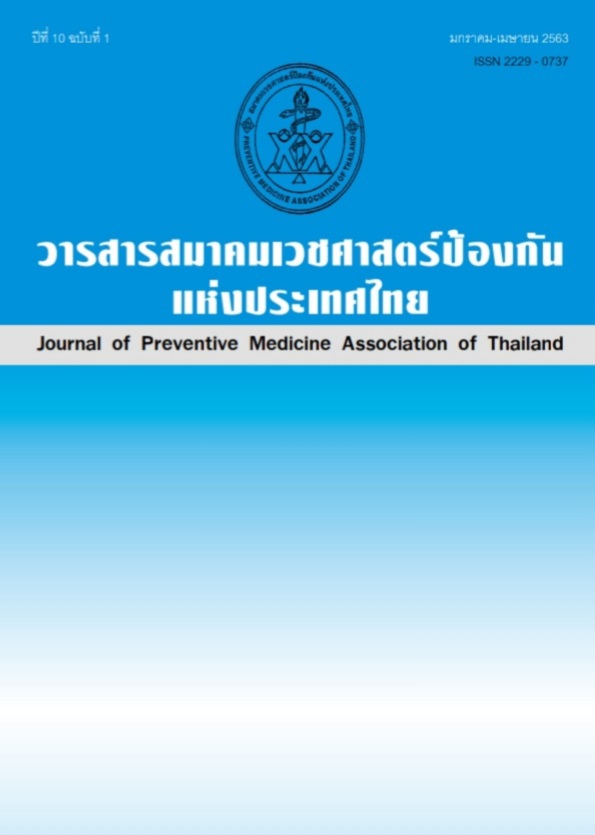ความชุกและปัจจัยที่เกี่ยวข้องกับความรู้สึกเป็นภาระ ของผู้ดูแลผู้ป่วยโรคหลอดเลือดสมอง
คำสำคัญ:
โรคหลอดเลือดสมอง, ภาระของผู้ดูแล, ความชุกบทคัดย่อ
โรคหลอดเลือดสมองเป็นหนึ่งในสาเหตุสำคัญของการเสียชีวิตและความพิการของทั่วโลก ผู้ป่วยโรคหลอดเลือดสมองอาจสูญเสียความสามารถในการทำกิจวัตรประจำวัน ส่งผลให้ต้องพึ่งพาผู้ดูแลในระยะยาว ดังนั้นผู้ดูแลผู้ป่วยจึงมีบทบาทสำคัญ ต้องแบกรับภาระงานมาก มีผลเสียต่อร่างกาย จิตใจ เศรษฐกิจ สังคมรวมถึงคุณภาพชีวิตของผู้ดูแล การศึกษาครั้งนี้มีวัตถุประสงค์เพื่อสำรวจความชุกของความรู้สึกเป็นภาระของผู้ดูแลและวิเคราะห์ปัจจัยที่เกี่ยวข้องกับความรู้สึกเป็นภาระของผู้ดูแลผู้ป่วยโรคหลอดเลือดสมองที่อาศัยในเขตเทศบาลนครพระนครศรีอยุธยา จังหวัดพระนครศรีอยุธยา ระหว่างเดือนตุลาคม-ธันวาคม พ.ศ. 2562 จำนวน 66 คน โดยใช้แบบบันทึกข้อมูลส่วนบุคคลของผู้ดูแลกับของผู้ป่วย และแบบประเมิน Zarit Burden Interview ฉบับภาษาไทย นำเสนอข้อมูลเป็นค่าร้อยละและความถี่ เปรียบเทียบข้อมูลระหว่างผู้ดูแลที่รู้สึกเป็นและไม่เป็นภาระด้วยการทดสอบ chi square กำหนดระดับนัยสำคัญทางสถิติที่ 0.05 พบว่าความชุกของความรู้สึกเป็นภาระร้อยละ 40.9 โดยมีปัจจัยที่เกี่ยวข้องกับความรู้สึกเป็นภาระได้แก่ รายได้เฉลี่ยต่อเดือนของครอบครัวในช่วง 0-5,000 บาท (p=0.041) ความกังวลเรื่องค่าใช้จ่ายมาก (p=0.014) และผู้ป่วยมีภาวะพึ่งพาโดยสมบูรณ์ (p=0.008) ส่วนผู้ดูแลที่เป็นบุคคลในครอบครัวลดความรู้สึกที่เป็นภาระของผู้ดูแลได้ ดังนั้นควรมุ่งเน้นบทบาทประสานความช่วยเหลือจากหน่วยงานที่เกี่ยวข้องในพื้นที่ เพื่อแบ่งเบาภาระค่าใช้จ่ายและส่งเสริมเรื่องการเพิ่มรายได้ของครอบครัวที่มีรายได้ต่ำ รวมทั้งสนับสนุนให้บุคคลในครอบครัวเป็นผู้ดูแลผู้ป่วย
เอกสารอ้างอิง
2. สำนักโรคไม่ติดต่อ กรมควบคุมโรค. ประเด็นสารรณรงค์วันอัมพาตโลก ปี 2561 [อินเทอร์เน็ต]. 2561 [เข้าถึงเมื่อ 26 พ.ย.2562]. เข้าถึงได้จาก: http://thaincd.com/document/file/download/knowledge/ประเด็นสารรณรงค์วันอัมพาตโลก_ปี2561.pdf
3. กองยุทธศาสตร์และแผนงาน สำนักงานปลัดกระทรวงสาธารณสุข. สถิติสาธารณสุข พ.ศ. 2561. นนทบุรี: กองยุทธศาสตร์และแผนงาน สำนักงานปลัดกระทรวงสาธารณสุข; 2562.
4. ปนัดดา ภักดีวิวรรธ, สุนทรา เลี้ยงเชวงวงศ์, สมบัติ มุ่งทวีพงษา. ปัจจัยทำนายการเคลื่อนไหวร่างกายของผู้ป่วยภายหลังการเกิดโรคหลอดเลือดสมองในระยะ 1 ปีแรก. วารสารพยาบาลทหารบก 2561;19:185-93.
5. Jaracz K, Grabowska-Fudala B, Gorna K, Jaracz J, Moczko J, Kozubski W. Burden in caregivers of long-term stroke survivors: Prevalence and determinants at 6 months and 5 years after stroke. Patient Educ Couns 2015;98:1011-6.
6. Wayne WD, Chad LC. Biostatistics: A foundation of analysis in the health sciences. 6th ed. New Jersey: John Wiley & Sons, Inc.; 1995.
7. กิ่งแก้ว ปาจรีย์. การฟื้นฟูสมรรถภาพผู้ป่วยโรคหลอดเลือดสมอง. พิมพ์ครั้งที่ 2. กรุงเทพฯ: งานตำราวารสารและสิ่งพิมพ์ สถานเทคโนโลยีการศึกษาแพทยศาสตร์ คณะแพทยศาสตร์ศิริราชพยาบาล มหาวิทยาลัยมหิดล; 2550.
8. Joan SG, Timothy RE, Michael W, Alfred AB, Joyce NG. Telephone intervention with family caregivers of stroke survivors after rehabilitation. Stroke 2002;33:2060–5.
9. ปิยะภัทร เดชพระธรรม, รัตนา มีนะพันธ์, ประเสริฐพร จันทร, สมลักษณ์ เพียรมานะกิจ, เสาวลักษณ์ จันทรเกษมจิต, อำไพ อยู่วัลย์. ความน่าเชื่อถือของแบบประเมินบาร์เธลฉบับภาษาไทยในผู้ป่วยโรคอัมพาตหลอดเลือดสมอง. เวชศาสตร์ฟื้นฟูสาร 2549;16:1-9.
10. ชนัญชิดาดุษฎี ทูลศิริ, รัชนี สรรเสริญ, วรรณรัตน์ ลาวัง. การพัฒนาแบบวัดภาระในการดูแลของผู้ดูแลผู้ป่วยเรื้อรัง. วารสารการพยาบาลและการศึกษา 2555;4:62-75
11. วิไล คุปต์นิรัติศัยกุล, พวงแก้ว ธิติสกุลชัย, สุพิน สาริกา, ศิริลักษณ์ แก้วนารี. ภาระของผู้ดูแลผู้ป่วยโรคหลอดเลือดสมอง 1 ปี หลังจำหน่ายออกจากโรงพยาบาล: การศึกษาสหสถาบัน. เวชศาสตร์ฟื้นฟูสาร 2561;28:8-14.
12. Rajesh K, Sukhpal K, Reddemma K. Burden and Coping Strategies in Caregivers of Stroke Survivors. J Neurol Neurosci 2015;S1:1-5.
13. ดุสิต จันทยานนท์, พัฒน์ศรี ศรีสุวรรณ, กองชัย วิเศษดวงธรรม, กิตติศักดิ์ วีระพลชัย, จุฑามาศ สุวรรณกนกนาค, ธันย์ชนก สุภาจารุพันธุ์ และคนอื่นๆ. ทัศนคติและผลกระทบจากการดูแลผู้ป่วยโรคหลอดเลือดสมองของผู้ดูแลในอำเภอพระนครศรีอยุธยา จังหวัดพระนครศรีอยุธยา. วารสารสมาคมเวชศาสตร์ป้องกันแห่งประเทศไทย 2554;1:59-65.
14. อุมาพร เคนศิลา, นิตยากร ลุนพรหม, ชุมพร ฉ่ำแสง, กิตติพงษ์ คงสมบูรณ์. ปัจจัยที่มีความสัมพันธ์กับภาระการดูแลผู้ป่วยโรคหลอดเลือดสมองของผู้ดูแลผู้ป่วย ศูนย์การแพทย์สมเด็จพระเทพรัตนราชสุดาฯ สยามบรมราชกุมารี. วารสารโรงพยาบาลสกลนคร 2560;20:41-9.
15. Tosun ZK, Temel M. Burden of caregiving for stroke patients and the role of social support among family members: an assessment through home visits. Int J Caring Sci 2017;10:1696-704.
16. Michael OO, Olumide OD, Olajire SO, Adesola CO, Morenike OO. Quality of life and burden of informal caregivers of stroke survivors. Hong Kong Physiother J 2014;32:6-12.
17. Serda E, Mehtap B, Mehmet C, Figen CC, Cemal K, Pelin O, et al. Psychological health of caregivers and association with functional status of stroke patients. Top Stroke Rehabil 2017;24:323-9.
18. Choi-Kwon S, Kim HS, Kwon SU, Kim JS. Factors affecting the burden on caregivers of stroke survivors in South Korea. Arch Phys Med Rehabil 2005;86:1043-8.
ดาวน์โหลด
เผยแพร่แล้ว
รูปแบบการอ้างอิง
ฉบับ
ประเภทบทความ
สัญญาอนุญาต
บทความที่ลงพิมพ์ในวารสารเวชศาสตร์ป้องกันแห่งประเทศไทย ถือเป็นผลงานวิชาการ งานวิจัย วิเคราะห์ วิจารณ์ ตลอดจนเป็นความเห็นส่วนตัวของผู้นิพนธ์ กองบรรณาธิการไม่จำเป็นต้องเห็นด้วยเสมอไป และผู้นิพนธ์จะต้องรับผิดชอบต่อบทความของตนเอง






